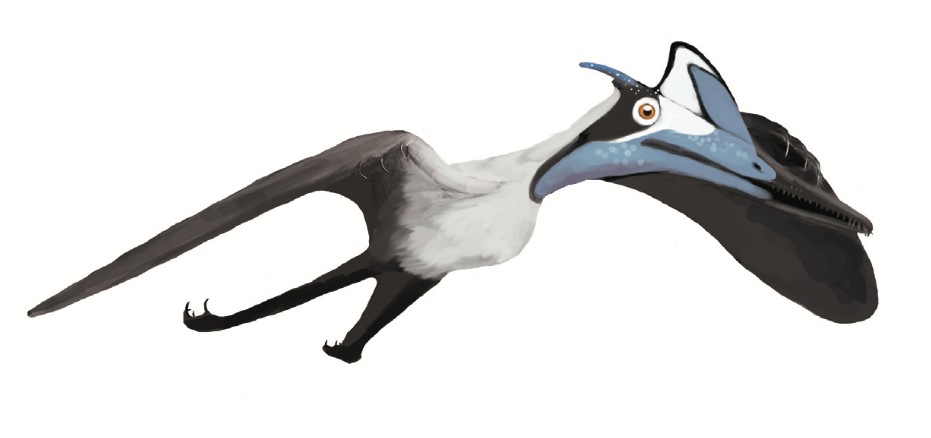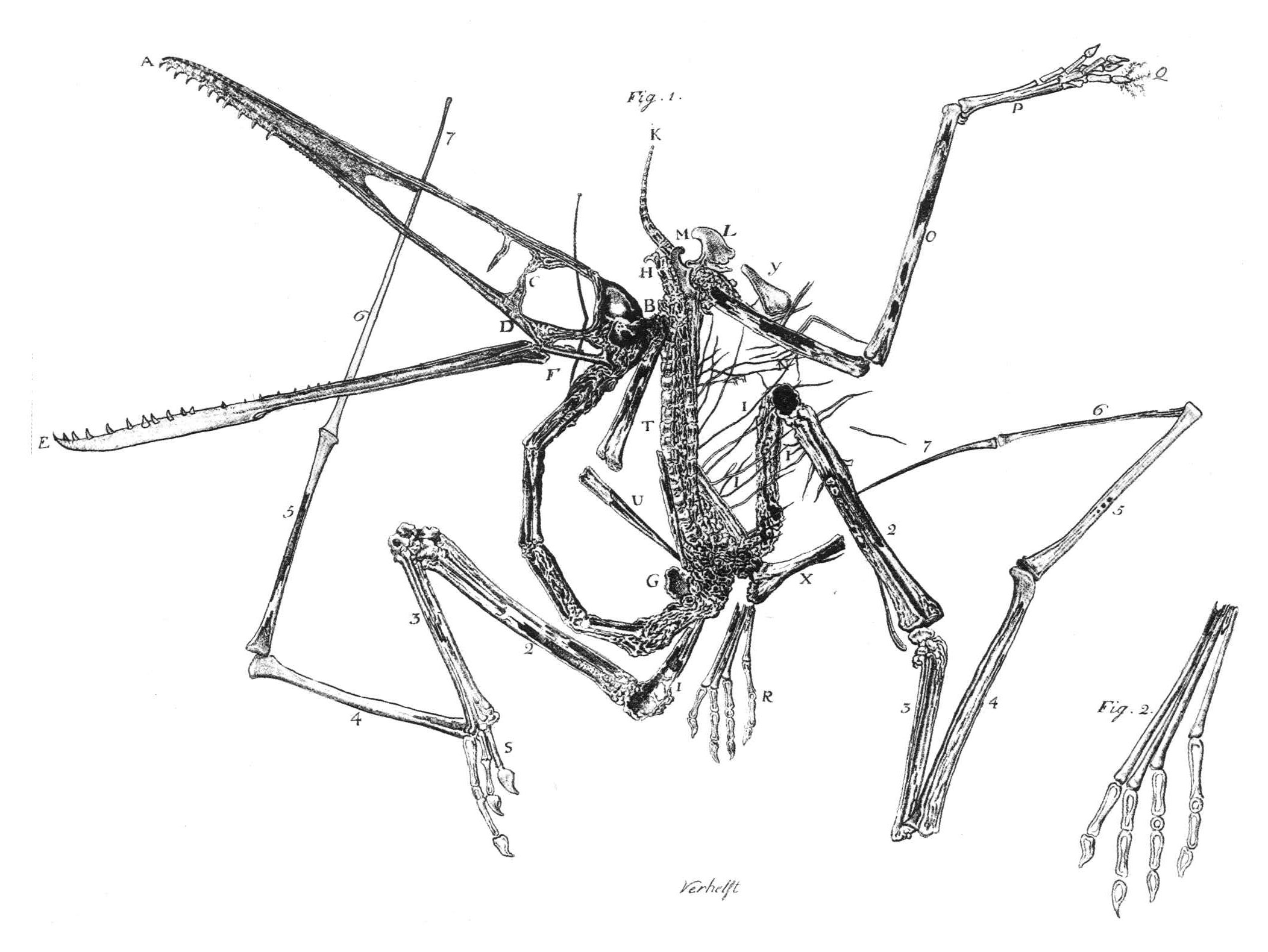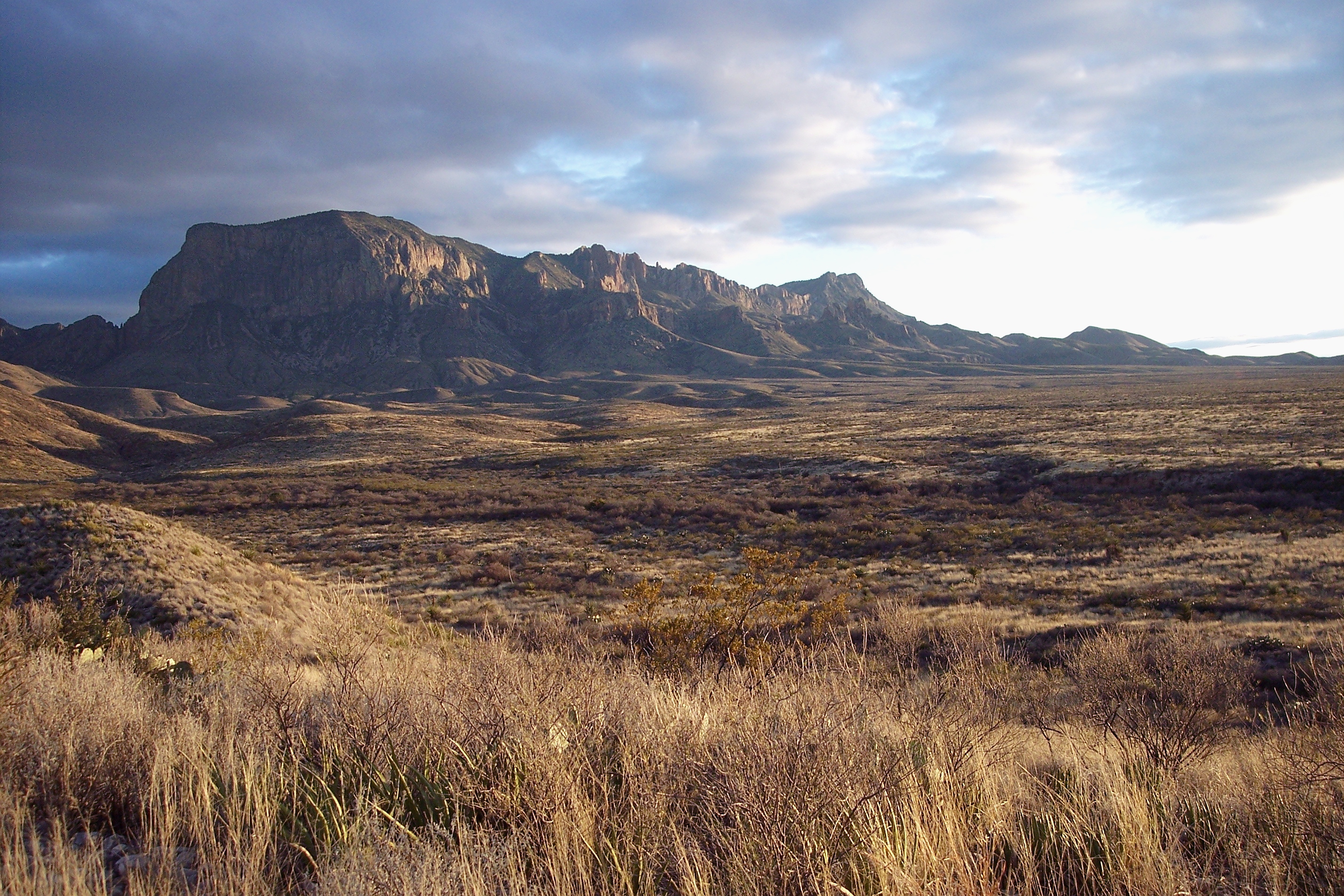|
Pterodactyl
Pterosaurs are an extinct clade of flying reptiles in the order Pterosauria. They existed during most of the Mesozoic: from the Late Triassic to the end of the Cretaceous (228 million to 66 million years ago). Pterosaurs are the earliest vertebrates known to have evolved powered flight. Their wings were formed by a membrane of skin, muscle, and other tissues stretching from the ankles to a dramatically lengthened fourth finger. There were two major types of pterosaurs. Basal pterosaurs (also called 'non-pterodactyloid pterosaurs' or 'rhamphorhynchoids') were smaller animals with fully toothed jaws and, typically, long tails. Their wide wing membranes probably included and connected the hind legs. On the ground, they would have had an awkward sprawling posture, but the anatomy of their joints and strong claws would have made them effective climbers, and some may have even lived in trees. Basal pterosaurs were insectivores or predators of small vertebrates. Later pterosa ... [...More Info...] [...Related Items...] OR: [Wikipedia] [Google] [Baidu] |
Monofenestrata
Monofenestrata is a clade of pterosaurs. It includes the pterosaurs in which the nasal and antorbital fenestra (openings/holes) in the skull are merged into a single fenestra. The clade includes the pterodactyloids and their close relatives. Classification The clade Monofenestrata was in 2010 defined as the group consisting of ''Pterodactylus'' and all species sharing with ''Pterodactylus'' the synapomorphy of an external nostril confluent with the antorbital fenestra, the major skull opening on the side of the snout. The name is derived from Greek ''monos'', "single", and Latin ''fenestra'', "window". The concept was inspired by the discovery of '' Darwinopterus'', a species combining a pterodactyloid-type skull with a more basal build of the remainder of the body. The Darwinoptera, a primitive subgroup of monofenestratans showing this transitional anatomy, was also named for ''Darwinopterus'' and defined as all descendants of its common ancestor with '' Pterorhynchus''. Belo ... [...More Info...] [...Related Items...] OR: [Wikipedia] [Google] [Baidu] |
Pterodactylus
''Pterodactylus'' (from ) is a genus of extinct pterosaurs. It is thought to contain only a single species, ''Pterodactylus antiquus'', which was the first pterosaur to be named and identified as a flying reptile and one of the first prehistoric reptiles to ever be discovered. Fossil remains of ''Pterodactylus'' have primarily been found in the Solnhofen limestone of Bavaria, Germany, which dates from the Late Jurassic period (Tithonian stage), about 150.8 to 148.5 million years ago. More fragmentary remains of ''Pterodactylus'' have tentatively been identified from elsewhere in Europe and in Africa. ''Pterodactylus'' was a generalist carnivore that probably fed on a variety of invertebrates and vertebrates. Like all pterosaurs, ''Pterodactylus'' had wings formed by a skin and muscle membrane stretching from its elongated fourth finger to its hind limbs. It was supported internally by collagen fibres and externally by keratinous ridges. ''Pterodactylus'' was a small pteros ... [...More Info...] [...Related Items...] OR: [Wikipedia] [Google] [Baidu] |
Allkaruen
''Allkaruen'' (meaning "ancient brain") is a genus of " rhamphorhynchoid" pterosaur from the Early Jurassic Cañadon Asfalto Formation in Argentina. It contains a single species, ''Allkaruen koi''. Description As demonstrated by a CT scan, the braincase of ''Allkaruen'' exhibits a unique set of traits that are intermediate between more basal pterosaurs such as ''Rhamphorhynchus'' and more derived pterodactyloid pterosaurs such as ''Anhanguera''. These traits are the position of the anterior semicircular canal of the inner ear, the relative orientations of the occiput and occipital condyle, the relative positions of the lateral margins of the flocculus and cerebral hemispheres, and the ratio between the length of the brain and the height of the hindbrain. In addition, the relative orientations of the frontal bone and lateral semicircular canal are more similar to ''Rhamphorhynchus'' than ''Anhanguera'', while the optic lobes are positioned lower than the forebrain as in pte ... [...More Info...] [...Related Items...] OR: [Wikipedia] [Google] [Baidu] |
Quetzalcoatlus
''Quetzalcoatlus'' () is a genus of azhdarchid pterosaur that lived during the Maastrichtian age of the Late Cretaceous in North America. The Type (biology), type specimen, recovered in 1971 from the Javelina Formation of Texas, United States, consists of several wing fragments and was species description, described as ''Quetzalcoatlus northropi'' in 1975 by Douglas A. Lawson, Douglas Lawson. The Generic name (biology), first part of the name refers to the Aztec serpent god of the sky, Quetzalcōātl, while the specific name, second part honors Jack Northrop, designer of a flying wing, tailless fixed-wing aircraft. The remains of a second species were found between 1972 and 1974, also by Lawson, around from the ''Q. northropi'' locality. In 2021, these remains were assigned to the name ''Quetzalcoatlus lawsoni'' by Brian Andres and (posthumously) Wann Langston Jr., Wann Langston Jr, as part of a series of publications on the genus. ''Quetzalcoatlus northropi'' has gained fame a ... [...More Info...] [...Related Items...] OR: [Wikipedia] [Google] [Baidu] |
Tropeognathus
''Tropeognathus'' (meaning "keel jaw") is a genus of large pterosaurs from the late Early Cretaceous of South America. This genus is considered to be a member of the family Anhangueridae, however, several studies have also recovered it within another family called Ornithocheiridae. Both of these families are diverse groups of pterosaurs known for their keel-tipped snouts and large size. ''Tropeognathus'' is regarded as the largest pterosaur found in the Southern Hemisphere, only rivaled by the huge azhdarchids. The type and only species is ''Tropeognathus mesembrinus''. Fossil remains of ''Tropeognathus'' have been recovered from the Romualdo Formation, which is a Lagerstätte located in the Santana Group of the Araripe Basin in northeastern Brazil. Discovery and naming In the 1980s the German paleontology museum ''Bayerische Staatssammlung für Paläontologie und historische Geologie'' in Munich acquired a pterosaur skull from Brazilian fossil dealers that had probably been ... [...More Info...] [...Related Items...] OR: [Wikipedia] [Google] [Baidu] |
Dimorphodon
''Dimorphodon'' ( ) is a genus of medium-sized pterosaur from Europe during the early Jurassic Period (about 201-191 million years ago).Müller R.T., Ezcurra M.D., Garcia M.S., Agnolín F.L., Stocker M.R., Novas F.E., Soares M.B., Kellner A.W.A. & Nesbitt S.J. (2023). ”New reptile shows dinosaurs and pterosaurs evolved among diverse precursors”. ''Nature'' 620(7974): p. 589–594. doi:10.1038/s41586-023-06359-z It was named by paleontologist Richard Owen in 1859. ''Dimorphodon'' means "two-form tooth", derived from the Greek () meaning 'two', () meaning 'shape' and () meaning 'tooth', referring to the fact that it had two distinct types of teeth in its jaws – which is comparatively rare among reptiles. The diet of ''Dimorphodon'' has been questioned among researchers, with earlier interpretations depicting it as an insectivore or a piscivore. Recent studies have suggested that ''Dimorphodon'' likely hunted small vertebrates, though it still would have consumed soft inver ... [...More Info...] [...Related Items...] OR: [Wikipedia] [Google] [Baidu] |
Anurognathidae
Anurognathidae is a family of small, short-tailed pterosaurs that lived in Europe, Asia, and possibly North America during the Jurassic and Cretaceous periods. Eight genera are definitively known: '' Anurognathus'', from the Late Jurassic of Germany; '' Jeholopterus'', '' Luopterus'', '' Cascocauda'' and '' Sinomacrops'', from the Middle to Late Jurassic of China; '' Batrachognathus'', from the Late Jurassic of Kazakhstan; and '' Dendrorhynchoides'' and '' Vesperopterylus'', from the Early Cretaceous of China. Bennett (2007) suggested that the holotype of '' Mesadactylus'', BYU 2024, a synsacrum, belonged to an anurognathid, though this affinity has been questioned by other authors. ''Mesadactylus'' is from the Late Jurassic Morrison Formation of the United States. Indeterminate anurognathid remains have also been reported from the Middle Jurassic Bakhar Svita of Mongolia and the Early Cretaceous of North Korea. Anurognathids had wingspans of up to 900 mm. Classification A ... [...More Info...] [...Related Items...] OR: [Wikipedia] [Google] [Baidu] |
Campylognathoides
''Campylognathoides'' is an extinct genus of pterosaur discovered in the Württemberg Lias deposits (dated to the early Toarcian ageBarrett, P. M., Butler, R. J., Edwards, N. P., & Milner, A. R. (2008). "Pterosaur distribution in time and space: an atlas". ''Zitteliana'', 61–107/ref>) of Germany; this first specimen however, consisted only of wing fragments. Further better preserved specimens were found in the Holzmaden shale; based on these specimens, Felix Plieninger erected a new genus. Discovery In 1858 Friedrich August Quenstedt named a new species of ''Pterodactylus'': ''P. liasicus''. It was based on a fossil, holotype GPIT 9533, consisting of some wing bones, found on the Wittberg near Metzingen in layers dating from the early Toarcian, about 180 million years old. The specific name referred to the Lias. Quenstedt thought he had identified long metacarpals in the wing, concluding that the new species was therefore not belonging to more basal genera, like the long ... [...More Info...] [...Related Items...] OR: [Wikipedia] [Google] [Baidu] |
Harry Govier Seeley
Harry Govier Seeley (18 February 1839 – 8 January 1909) was a British paleontologist. Early life Seeley was born in London on 18 February 1839, the second son of Richard Hovill Seeley, a goldsmith, and his second wife Mary Govier. When his father was declared bankrupt, Seeley was sent to live with a family of piano makers. Between the ages of eleven and fourteen, he went to a day school and then spent the next two years learning to make pianos. He also attended lectures at the Royal School of Mines by Thomas Henry Huxley, Edward Forbes, and other notable scientists. In 1855, with the support of his uncle, Seeley began to study law but shortly gave it up to pursue a career as an actuary. In the late 1850s, he studied English and mathematics at the Working Men's College and served as a secretary for the college's museum. He also worked in the library of the British Museum, where Samuel Pickworth Woodward encouraged him to study geology. In 1859, Seeley began studies at Sidney ... [...More Info...] [...Related Items...] OR: [Wikipedia] [Google] [Baidu] |
Rhamphorhynchidae
Rhamphorhynchidae is a group of early pterosaurs named after '' Rhamphorhynchus'', that lived in the Late Jurassic. The family Rhamphorhynchidae was named in 1870 by Harry Govier Seeley.Seeley, H.G. (1870). "The Orithosauria: An Elementary Study of the Bones of Pterodactyles." Cambridge, 135 p. Members of the group possess no more than 11 pairs of teeth in the rostrum, a deltopectoral crest that is constricted at the base but expanded at the distal end, and a bent phalange on the fifth toe. Rhamphorhynchidae traditionally contains two subfamilies: the Rhamphorhynchinae and the Scaphognathinae. While not recovered as distinct clades by all analyses, there do appear to be traits uniting members of each group. Rhamphorhynchines are more common, were lightly built, and had jaws ending in pointed tips that contained more teeth, which are often procumbent (pointed forward). Scaphognathines are comparatively quite rare, were more robust skeletally, and had shorter wing proportions. The ... [...More Info...] [...Related Items...] OR: [Wikipedia] [Google] [Baidu] |
Fossil
A fossil (from Classical Latin , ) is any preserved remains, impression, or trace of any once-living thing from a past geological age. Examples include bones, shells, exoskeletons, stone imprints of animals or microbes, objects preserved in amber, hair, petrified wood and DNA remnants. The totality of fossils is known as the ''fossil record''. Though the fossil record is incomplete, numerous studies have demonstrated that there is enough information available to give a good understanding of the pattern of diversification of life on Earth. In addition, the record can predict and fill gaps such as the discovery of '' Tiktaalik'' in the arctic of Canada. Paleontology includes the study of fossils: their age, method of formation, and evolutionary significance. Specimens are sometimes considered to be fossils if they are over 10,000 years old. The oldest fossils are around 3.48 billion years to 4.1 billion years old. Early edition, published online before prin ... [...More Info...] [...Related Items...] OR: [Wikipedia] [Google] [Baidu] |
Late Triassic
The Late Triassic is the third and final epoch (geology), epoch of the Triassic geologic time scale, Period in the geologic time scale, spanning the time between annum, Ma and Ma (million years ago). It is preceded by the Middle Triassic Epoch and followed by the Early Jurassic Epoch. The corresponding series (stratigraphy), series of rock beds is known as the Upper Triassic. The Late Triassic is divided into the Carnian, Norian and Rhaetian Geologic time scale, ages. Many of the first dinosaurs evolved during the Late Triassic, including ''Plateosaurus'', ''Coelophysis'', ''Herrerasaurus'', and ''Eoraptor''. The Triassic–Jurassic extinction event began during this epoch and is one of the five major mass extinction events of the Earth. Etymology The Triassic was named in 1834 by Friedrich August von Namoh, Friedrich von Alberti, after a succession of three distinct rock layers (Greek meaning 'triad') that are widespread in southern Germany: the lower Buntsandstein (colourful ... [...More Info...] [...Related Items...] OR: [Wikipedia] [Google] [Baidu] |










